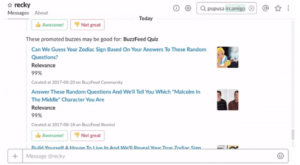12 Things You Didn’t Know About BuzzFeed and Machine Learning

How BuzzFeed competes in a changing digital media landscape.
In today’s world of digital media, where there are no barriers to entry and distribution is dominated by social networks, how does a company effectively capture consumer time? BuzzFeed’s answer has been an increased focus on machine learning to create efficiencies in content production and distribution.

(Source: BuzzFeed)

(Source: BuzzFeed)
BuzzFeed is one of the world’s largest digital media companies, generating over 65 billion video views in 2017 across social platforms such as Facebook, YouTube, and Snapchat [1]. They produce 1,200+ new pieces of content every week and distribute them across 400+ social accounts [2].
Digital Media Landscape
Over the past few years online media consumption has shifted to social networks as publisher owned websites see significant declines in engagement [3]. The open nature of social platforms has created a highly fragmented and saturated content environment. It is extremely difficult for premium publishers to surface their content as they compete for time with everything from low cost blogs to a user’s friends and family. Advertising dollars have followed the trend in viewership. Almost 90% of digital advertising growth in 2017 was captured by tech platforms [4]. These trends are forcing publishers to create more content at lower costs in order to stay viable.
Machine learning can address these challenges in two major ways: cutting content production costs and creating more efficient distribution. Content production can be impacted by cutting out many manual processes. For example, the AP implemented a machine learning program to reduce the 800 hours a week spent converting print stories to broadcast formats [3] and Forbes and LA Times are experimenting with fully automated basic news content [5]. The distribution process can be improved by effectively predicting when and where specific content should be published to maximize consumer discovery. One case is the New York Times’ Blossom app that decides which stories deserve additional promotion [6]. BuzzFeed is especially well positioned to take advantage of machine learning as their current scale gives them an initial data advantage over other publishers.
Machine Learning at BuzzFeed

(Source: BuzzFeed)
BuzzFeed has already implemented a number of machine learning applications in their short-term strategy. For distribution, because they produce so much content and have so many different channels, they need to quickly identify the content that will drive the most engagement. Their current machine learning tools are able to recommend what content will work well on a specific page or what the ideal posting time will be, as well as A/B test thumbnails and titles so posts can be automatically optimized for both [7]. They also incorporate a feedback loop where dismissed recommendations are pushed back into the model letting it learn over time [2].
In terms of content production, BuzzFeed’s PubHub tool implements time saving initiatives such as auto generating YouTube descriptions [2]. Additionally, they have tools that drive new content decisions by suggesting topics or formats that work for specific audience types. They can also bunch together high performing content to better identify trends. For example, they had an early insight that videos with cheese being pulled were particularly engaging, which helped launch some of their food brands [7].
Over the long-term, BuzzFeed is working to create a much faster experimentation process to iterate on machine learning algorithms. They believe this will lower the threshold for publication and get products out much faster. Additionally, they are planning to experiment with neural networks through third party applications, giving tools the power to make simple content decisions such as title changes [8].
Suggested Steps
One suggestion for BuzzFeed is to give their tools more flexibility to execute decisions. Currently BuzzFeed doesn’t see machine learning as able to actually give production input or pull creative insights [8]. While machine learning cannot create wholly new, creative content, much of BuzzFeed’s content is based on historic iteration for new markets or topics and could be optimized. In the short term I would suggest letting their tools auto post iterated content or cross post to multiple accounts. In the long term I believe the content based on historic iteration should be fully created by a machine learning tool, with some human oversight.
Additionally, BuzzFeed currently has a competitive data advantage and it is important to maintain this. Current plans are to have some future machine learning programs licensed through third parties since the investment to produce in house is too high [8]. But I believe it is important to make that investment themselves in order to capitalize on their data advantage while they have it, and not level the playing field by being reliant on third parties.
When reflecting on BuzzFeed’s machine learning strategy two major questions are highlighted: can machine learning or AI ever fully replicate the creativity of human content producers? and how much financial risk should BuzzFeed take on to invest in machine learning programs?
(Word Count: 797)
Sources:
[1] Danielle Lepe. “How BuzzFeed Built a 60 Billion Video View Powerhouse”. Tubular Insight, July 2018. https://tubularinsights.com/buzzfeed-60-billion-video-views/.
[2] Swara Kantaria. “How We’re Building Superpowers for Social Publishers at BuzzFeed”. BuzzFeed, September 2018. https://tech.buzzfeed.com/how-were-building-superpowers-for-social-publishers-at-buzzfeed-ac24fad5ae11.
[3] Jessica Rovello “Machine Learning will give Publishing Visual, Interactive Content on a Big Scale”. Ad Age, March 2017. https://adage.com/article/digitalnext/future-publishing-visual-interactive-content-scale/308439/
[4] Internet Advertising Bureau. “2017 IAB Internet Advertising Report”. IAB, May 2018. https://www.iab.com/wp-content/uploads/2018/05/FY-2017-IAB-Internet-Advertising-Revenue-IAB-Webinar-Presentation-05-10-2018.pdf
[5] Andreas Graefe. “Guide to Automated Journalism”. Columbia Journalism Review, January 2016. https://www.cjr.org/tow_center_reports/guide_to_automated_journalism.php
[6] John Ellet. “New AI-Based Tools Are Transforming Social Media Marketing”. Forbes, July 2017. https://www.forbes.com/sites/johnellett/2017/07/27/new-ai-based-tools-are-transforming-social-media-marketing/#7276936769a2
[7] Max Willens. “How BuzzFeed gets its employees data-focused”. Digiday, March 2017. https://digiday.com/media/buzzfeed-gets-employees-data-focused/
[8] Interview with BuzzFeed Principal Data Scientist Adam Kelleher. Dataframed, February 2018. https://www.datacamp.com/community/podcast/buzzfeed-digital-media



Amazing article ! Thank you for sharing. AI is definitely changing the content marketing world. I share your thoughts regarding the power of AI within the marketing industry. How far could it go ? AI made incredible progress in just a few years, so I am pretty convinced that we haven’t seen it all. I believe this also raises another question for Buzzfeed : how will they maintain competitive advantage ? Google for example is extremely advanced with its AI technology, also has a lot of data and content. If AI can fully replace human creativity, then Google might easily replace Buzzfeed…
“When reflecting on BuzzFeed’s machine learning strategy two major questions are highlighted: can machine learning or AI ever fully replicate the creativity of human content producers? and how much financial risk should BuzzFeed take on to invest in machine learning programs?”
Great questions!
I also wonder how “creative” human content producers really are nowadays – so much content on the internet is just a rehash of something that’s already been done. So while ML might not be able to create sublime content, it might be good enough for 80% of what’s out there.
Ah. And we come back to the BIG question: Can machines be creative? As a designer and lover of art, I have a very hard time thinking that technologies can and/or should ever replace the human intellect. When it comes to matters of efficiency or operations, I really appreciate leveraging technologies like AI. However, reading a Buzz Feed article that was written by a computer and revised by a human just does not seem appealing to me. Am I so predictable that a computer knows what I want or would like better than my family, friends or even myself? AI technologies are getting so powerful that the truthful answer is: probably, yes. That said, that is not a world I want. Just something to keep in mind about the irrationality of human thought.
Extremely interesting topic! Thank you for posting, really enjoyed the way you laid out the situation!
We have debated this some in class and I see some other comments picked up on this, but the question of AI / machine learning processes being creative as the future is an interesting concept and a great question. I think your opinion is spot on with iterations of content being done by machines with human oversight. I might start having machines suggest original content and have humans develop the concept as well.
In terms of the investment I think BuzzFeed should be making in machine learning programs, I believe the company needs to invest as many dollars as possible into this. As you mentioned in your post, the company currently has a huge data advantage over the competition and they need to take advantage of this as quickly as possible.
The machine learning tools that BuzzFeed has already developed seem to already be paying dividends. The feedback loop the company has developed is an extremely valuable tool that can help the company optimize both timing and channel. Given the competition for attention on these channels (other media content, pictures of family and friends, etc.), the company must invest in machine learning to gain as much insight into their end consumers as possible!